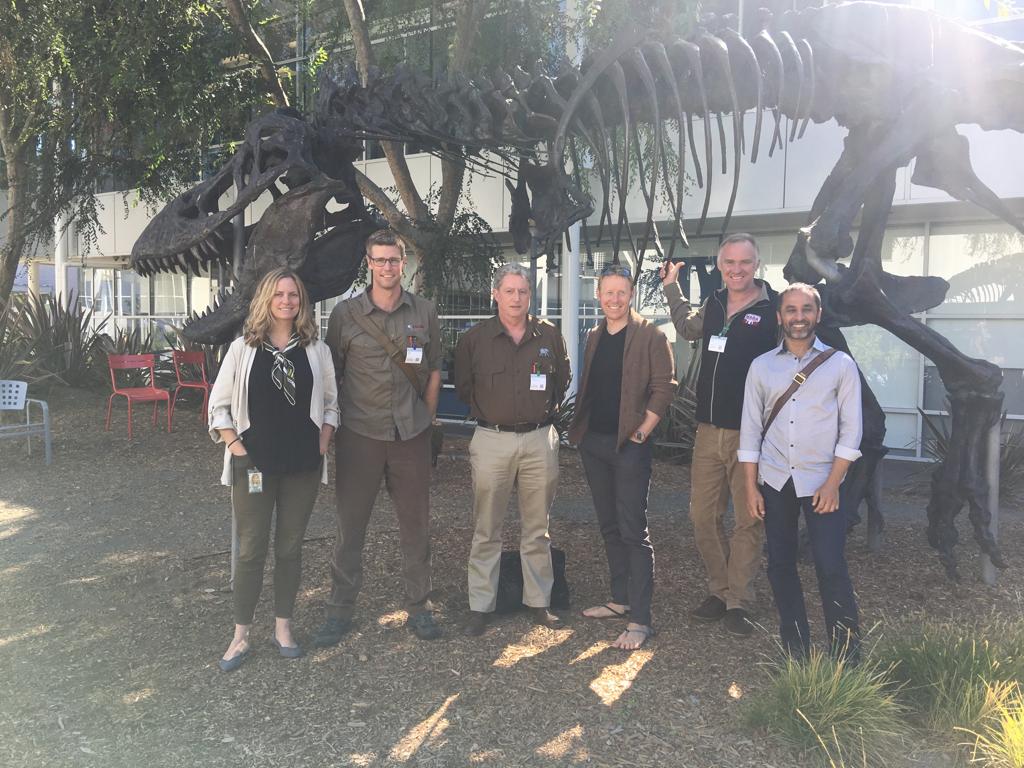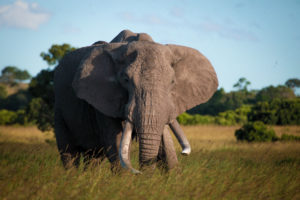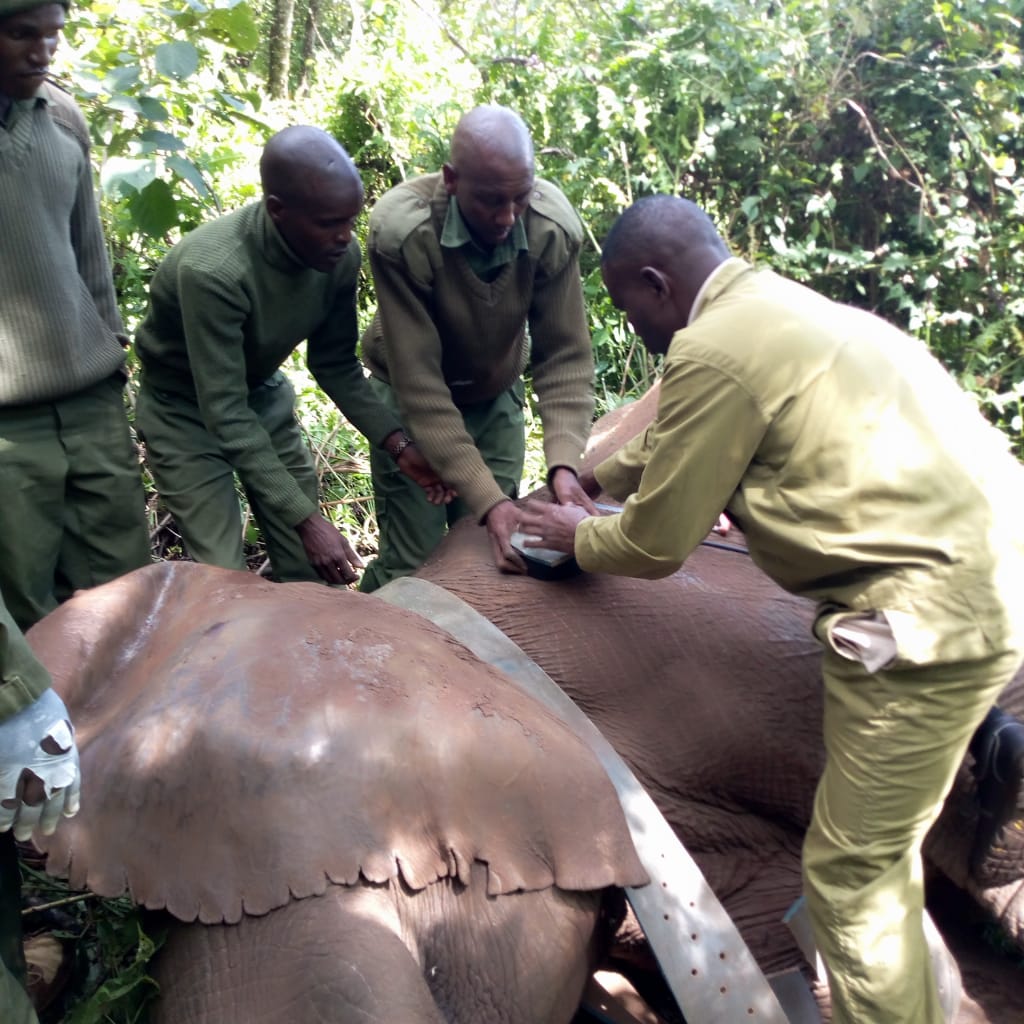The Research Report for the fourth quarter begins with a happy announcement which is that the Director of Research and Conservation Dr. Jake Wall and his fiancé Christina Toms welcomed a healthy baby boy in early October. It was good timing as Jake spent the two weeks prior in the United States on a fundraising trip where he and MEP CEO Marc Goss presented at the Google Headquarters in California.

MEP CEO Marc Goss and Director of Research & Conservation at Google HQ.
The fence mapping exercise had some exciting developments in the fourth quarter. In November, MEP purchased a new Kibo motorbike (made locally in Kenya) to progress the fence line mapping field work. MEP’s dedicated spatial data research field assistant can now move around quickly while using the Njia app to work his way, starting with Pardamat, across the Mara and filling in the map with new fence lines and roads. In conjunction with the landDx database we hope to make further progress in mapping fence proliferation across the Mara into early 2020. The MEP research department met with Rebekah Karimi, the manager of Enonkishu Conservancy, in October to discuss MEP’s involvement in a fencing project on the northwest boundary of Enonkishu that would help prevent elephants moving into community areas to crop raid. The area has been a major source of conflict and a fence may improve the situation. Very little elephant range would be affected by this fence and it would significantly reduce crop-raiding incidents.

The new fence mapping motorbike.
 In MEP collared elephant news, the most significant announcement was in December when Hugo, our biggest bull, died of natural causes on the bank of the Mara River within the Maasai Mara National Reserve near Musiara swamp – a favorite location of his (pictured left). We’ve since recovered his skull to keep as an educational tool at MEP HQ. His molars were very worn indicating an advanced age and therefore the likely explanation is that he died of old-age and malnutrition. Although a tremendous loss, it’s nice to think he lived out his days in peace. In November, MEP collared the 20th elephant monitored in real-time daily; Alice, in the Mau Forest. Alice and her herd have since been crop raiding and required MEP rangers to mitigate conflict in several instances in December. We had several collared elephants seen by rangers in large herds, Namunyak was seen with the herd of 30 by a MEP ranger team, Chelsea was spotted with a herd of 40 elephants and Ivy’s herd had reached the size of 30 elephants. Kegol and Fred spent most of this reporting period together after the loss of Hugo and collared elephants Hannibal and Napolean spent the reporting period together and Fitz was visited several times by rangers.
In MEP collared elephant news, the most significant announcement was in December when Hugo, our biggest bull, died of natural causes on the bank of the Mara River within the Maasai Mara National Reserve near Musiara swamp – a favorite location of his (pictured left). We’ve since recovered his skull to keep as an educational tool at MEP HQ. His molars were very worn indicating an advanced age and therefore the likely explanation is that he died of old-age and malnutrition. Although a tremendous loss, it’s nice to think he lived out his days in peace. In November, MEP collared the 20th elephant monitored in real-time daily; Alice, in the Mau Forest. Alice and her herd have since been crop raiding and required MEP rangers to mitigate conflict in several instances in December. We had several collared elephants seen by rangers in large herds, Namunyak was seen with the herd of 30 by a MEP ranger team, Chelsea was spotted with a herd of 40 elephants and Ivy’s herd had reached the size of 30 elephants. Kegol and Fred spent most of this reporting period together after the loss of Hugo and collared elephants Hannibal and Napolean spent the reporting period together and Fitz was visited several times by rangers.

The Alice collaring operation in the Mau Forest.
Mara Elephant Project would also like to extend our sincerest thanks to Olarro Conservancy for supporting the purchase of five satellite elephant collars in the fourth quarter. These collars are from a new supplier. We are looking forward to deploying these collars in 2020 and working together with Olarro to protect elephants in this ecosystem. Olarro has been instrumental in mitigating conflict around their conservancy and protecting elephants in the Siana area and it’s wonderful to have such a committed partner.
In terms of the increasing habitat protection efforts by MEP rangers, in December, the MEP research department organized to meet with KWS, NCG the District Commissioner (Narok), NEMA and the Kenya Forestry Service to discuss the deforestation crisis happening in Nyakweri Forest. It was agreed at this meeting to follow up with a barasa in January to help inform local forest inhabitants about the laws preventing forest cutting and to subsequently perform joint patrols with MEP, KWS and KFS. Sixty percent of the forest has been cutdown in the last 20 years and is an important elephant range area that needs more protection.
In early November, MEP hosted Dr. George Wittemyer at HQ and had meetings about designing an elephant sighting protocol to answer questions about the Mara elephant population. We plan to implement the new sighting protocol in January 2020. Dr. Wittemyer recently attained tenure at Colorado State University and is a welcomed advisor to MEP. We hosted Dennis Schneider from Vulcan who is helping MEP with our EarthRanger system. He especially helped us to configure GLAD alerts disseminated by Global Forest Watch and the University of Maryland. These alerts identify areas that have been deforested in near real-time based on Landsat imagery. We’ve begun using the alert location as patrol targets for our ranger teams and have been able to identify many more illegal logging sites across the Mau, Nyakweri and Loita forests than in previous months.

In December, Director of Research and Conservation Dr. Jake Wall and CEO Marc Goss attended the 12th Annual Wildlife Research Conference in Arusha, Tanzania (pictured left). Both Marc and Jake found it very interesting to hear about all of the research projects across the country and catch up with our partners across the border at Tanzania Wildlife Research Institute (TAWIRI) to renew our collaboration in protecting elephants in Northern Tanzania.


